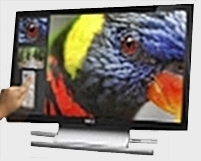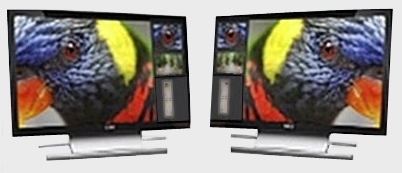Podium Computer Monitors
Linked directly to the classroom podium computer, the podium computer monitor provides the presenter a view of the computer's desktop to set up a presentation or serve as a confidence monitor during a presentation. In almost every centrally supported classroom, the monitor is secured to an adjustable arm that allows the presenter to move it to a suitable location for their presentation. There are a few podium monitor configurations found in centrally managed classrooms, so please review the MCV and MPC room resources directories for your specific monitor configuration needs.
Single Monitor Podiums
 Classrooms with limited space in the front of the room, or systems that have basic standard capabilities have a small podium in the front of the room that can accommodate a single podium monitor mounted on top. By design, these monitors will only display the desktop of the podium computer.
Classrooms with limited space in the front of the room, or systems that have basic standard capabilities have a small podium in the front of the room that can accommodate a single podium monitor mounted on top. By design, these monitors will only display the desktop of the podium computer.
A single touch-screen monitor on an adjustable arm, ranging in size from 21.5 inches to 23 inches.
Dual Monitor Podiums
 Lecture halls or large classrooms with complicated systems require additional space for all of the equipment to be stored. As a result, the podium surface area increases, allowing the accommodation of two podium monitors mounted on top of the podium. The left, or primary podium monitor will show the podium computer's desktop at all times. With the addition of a second monitor on the right side of the podium, allows more flexibility as to what can be previewed. Typically the second monitor displays the podium computer's extended desktop, and serves as a preview monitor for other system sources (i.e. document camera). Please review the system training documentation for your specific room for more information.
Lecture halls or large classrooms with complicated systems require additional space for all of the equipment to be stored. As a result, the podium surface area increases, allowing the accommodation of two podium monitors mounted on top of the podium. The left, or primary podium monitor will show the podium computer's desktop at all times. With the addition of a second monitor on the right side of the podium, allows more flexibility as to what can be previewed. Typically the second monitor displays the podium computer's extended desktop, and serves as a preview monitor for other system sources (i.e. document camera). Please review the system training documentation for your specific room for more information.
With two touch-screen monitors, either the primary or extended desktop of the podium computer can be interactive, using the capacitive touch functionality of these monitors. Either finger or capacitive touch stylus can be used with these monitors. NOTE: When the secondary podium monitor (right monitor) is being used as a preview display for other sources like the document camera, the touch interaction will still communicate with the extended desktop. It does not annotate the preview content.